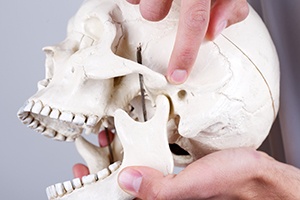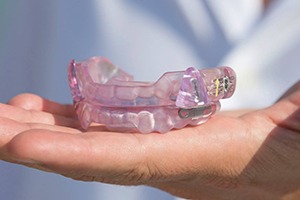TMJ / TMD Therapy
Relief from Chronic Jaw Pain & Headaches
Your temporomandibular joint, or TMJ, refers to the set of hinges on your jaw that allows it to move smoothly whenever you eat, speak, laugh, or yawn. Like other joints in the body, it can sometimes become strained or misaligned, leading to what is called a TMD, or temporomandibular joint disorder. This can cause a wide variety of dental and overall health problems, so if a stiff, painful jaw or persistent migraines are common issues for you, you should contact Dr. Gabriel Nossa today to get the relief you need.
Diagnosis & Treatment

A TMD can be caused by a wide variety of factors, but the most common tend to be stress, injury, arthritis, and a misalignment of the bite. When the teeth don’t quite come together properly, this causes the jaw to make slight adjustments whenever you open and close your mouth, and this puts quite a bit of strain on the joint and adjoining muscles. When you come to see us and we suspect that you have TMD, we’ll use a variety of tests and scans to reveal the root of your problem so we can quickly start treating it.
Equilibration / Occlusal Adjustments

When the bite is slightly misaligned, this can sometimes cause muscle tension and pain in the jaw. In order to align the bite and relieve this discomfort, we can perform what is called an equilibration/occlusal adjustment. Despite that being a mouthful, the treatment only entails slightly reshaping a few teeth in order to help your bite come together smoothly. This will allow the jaw muscles to relax, and the pain should eventually go away.
Occlusal Splints

We can also prescribe the use of an occlusal splint, which is a custom-made orthopedic mouthpiece that slightly shifts the jaw into a more comfortable and natural position. This will allow the joint and muscles to relax and heal themselves over time. Many patients are able to stop wearing a splint after a few months of use, though others will need to keep wearing it in order to maintain results.
TMJ Treatment FAQs
Can TMJ Be Cured Permanently?
Discomfort associated with TMJ disorder can sometimes go away on its own over time. However, if your symptoms are having a significant impact on your everyday life, you will want to visit a professional for treatment. Occlusal splints and occlusal adjustments/equilibration are both designed to permanently address the jaw tension, misalignment, or other underlying causes of TMD, resulting in lasting relief.
Is TMJ Treatment Safe?
Once you are receiving TMJ treatment from a qualified professional, the process should be completely safe. However, it is often recommended to treat TMJ disorder with as minimally invasive and conservative methods as possible. Occlusal splints and equilibration/occlusal adjustments have both been proven to be overwhelmingly safe for addressing TMD.
How Long Does TMJ Treatment Take?
While some at-home jaw exercises can provide immediate yet temporary relief, long-term relief typically requires treatment from a medical professional. The timeline depends on the specific treatments necessary, which can vary based on the cause and severity of your TMJ disorder. Occlusal splints are worn at night for a few weeks to several months before patients notice their symptoms being alleviated. Equilibration/occlusal adjustments can vary in how quickly they provide relief, depending on the changes to be made. However, once the bite is better aligned, most patients experience some relief very soon afterward.
Does Occlusal Adjustment for TMJ Hurt?
No matter which changes need to be made to properly align your teeth, we will make sure your treatment is as comfortable as possible. In most cases, occlusal adjustment is performed by precisely filing down the biting surfaces of the teeth or restorations that protrude and throw off the bite’s overall balance. This is done to alleviate stress on the jaw joints without negatively impacting your oral health. In some cases, occlusal adjustment can involve adding to existing dental structures. Depending on your case, we may or may not need to administer a local anesthetic to numb your mouth beforehand.
Can TMJ Be Treated Without Surgery?
In most cases, yes. In fact, the NIH recommends using the most conservative approach possible. Surgically treating a TMJ disorder means making permanent changes to the jaw and nearby facial anatomy, which isn’t ideal. Our equilibration/occlusal adjustments and occlusal splints are non-invasive and, more often than not, can alleviate TMJ complications without significantly altering your facial structure.
Is TMJ Treatment Covered by Insurance?
The answer to this is rather involved. Basically, current Florida law protects medically necessary diagnostic and surgical procedures for the TMJ, but doesn’t necessarily require insurance providers to offer coverage for all types of TMJ treatment. Unless your disorder was caused by injury or disease or significantly impairs your oral function, medical insurance is unlikely to provide coverage. Dental insurance, on the other hand, usually provides at least some coverage.
Rest assured, our team will thoroughly review your insurance plan to make sure you save as much money as possible. If you have any questions or concerns about your coverage, please give us a call!
Can TMJ Treatment Help with Sleep Apnea?
It’s definitely possible! The two often go hand-in-hand, as a misaligned jaw or muscle tension can contribute to obstructive sleep apnea. Treating a TMJ disorder with an oral appliance can help free up your airway or relax your facial muscles, alleviating bothersome sleep apnea symptoms. The reverse is true, too – sleep apnea appliances can help reposition your jaw and ease the pressure being exerted on your TMJ.
If you suspect you have a TMJ disorder and sleep apnea, be sure to let our team know. We’ll be able to help you create an effective treatment plan that addresses both conditions!
Can I Get Invisalign if I Need TMJ Treatment?
Actually, Invisalign can sometimes be used as a TMJ treatment! If your symptoms are caused by a misaligned bite or crooked teeth, straightening them out with Invisalign could indeed solve the root problem. That said, we still recommend scheduling a consultation so we can thoroughly evaluate your teeth, jaw, and TMJ. A visual exam and X-rays will give us a better understanding of your TMJ disorder and what types of treatments are likely to work best.
